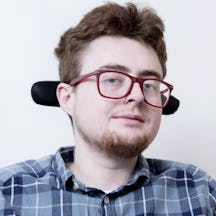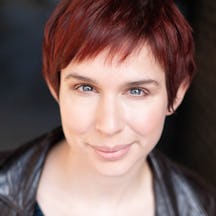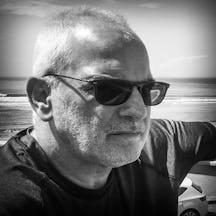Drama school never seemed like an option for Jamie Hale until they found Graeae’s Ensemble. In conversation with the theatre company’s artistic director, Jenny Sealey, they discuss creating inclusive spaces, ticking boxes and whether non-disabled actors should ever play disabled parts.
Acting, disableism and inclusive theatre
Words by Jamie Haleaudio by Kirsten Irvingphotography by Patrick Baldwinaverage reading time 6 minutes
- Article

Listen
“It was like an epiphany: the whole world made sense. I was allowed to be Deaf in a way I’d never been allowed to be before.” After finding D/deaf and disabled theatre 40 years ago, director Jenny Sealey now can’t imagine life outside of it.
Art coming from these communities has different principles, intentions and inclusiveness. It might be multilingual, with integrated audio-description, creative captions and British Sign Language woven into it. Rehearsals might have taken far longer, to allow actors time to rest.
In my experience the complete process, from writing to directing, is far more collaborative than elsewhere in the theatre world. Disabled people know what it’s like to be excluded, so we attempt to ensure that our own practice is designed to be as accessible as possible to everyone.
Accessibility has been Jenny’s life’s work. And Graeae – the D/deaf and disabled theatre company founded in 1980 and which Jenny has directed since 1997 – has led the way on integrating D/deaf and disabled creative practitioners into the theatre world. Jenny describes her mission as being to make Graeae a “safe place for [D/deaf and disabled] artists who want to be actors, writers and directors”.
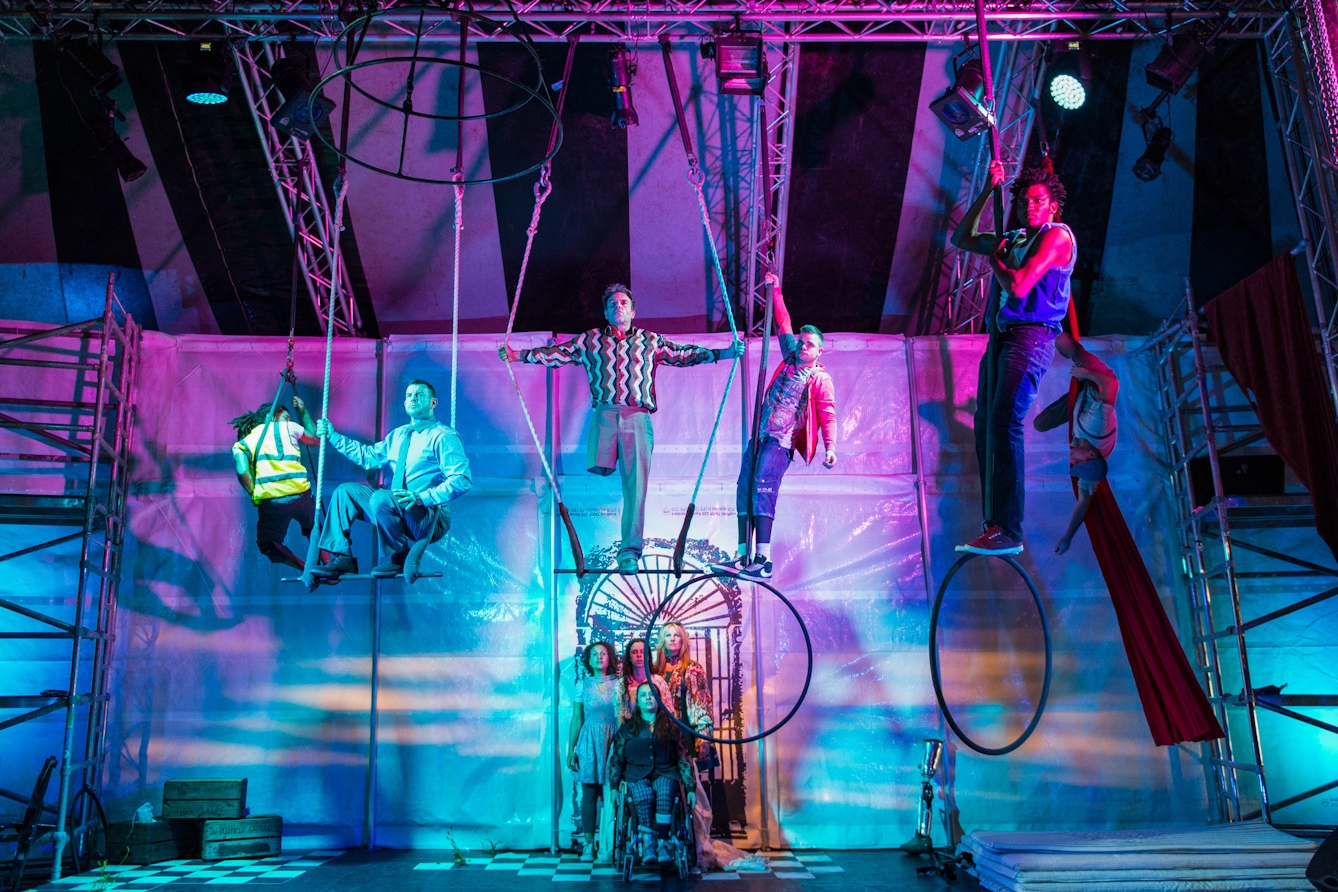
Performance of Belonging, presented by Graeae and Circo Crescer e Viver, 2014.
A route into professional theatre
I am one of the beneficiaries of Jenny’s relentless drive to create opportunities for D/deaf and disabled actors. I’m part of Graeae’s Ensemble – a Certificate of Higher Education in Theatremaking and Leadership accredited by Rose Bruford and in conjunction with the drama schools RADA, Central School of Speech and Drama, and LAMDA.
Drama school would never have seemed possible for me as a disabled artist, but here Graeae have created a type of drama education that works with us, rather than against us. It’s offered me training and support, and the experience I need to work in big theatres, whether as part of a D/deaf and disabled cast, or as the only disabled writer, actor or director.
The programme was set up in response to the lack of professional training for D/deaf and disabled theatremakers. Jenny has “been banging on the doors of drama schools for 24 years and there’s incremental change but not enough – there’s still that weird ethos that there aren’t enough parts written for disabled characters”.
Jenny tells me that, in fact, more parts are being written: “The rise of Ramps on the Moon [which aims to normalise the presence of D/deaf and disabled people in theatre, both on and off stage] is an absolute indication that there are jobs for D/deaf and disabled actors; we’re worth the training.”
Belonging, 2014

Jenny Sealey directs a performer during rehearsals for Belonging, a production presented by Graeae and Circo Crescer e Viver.
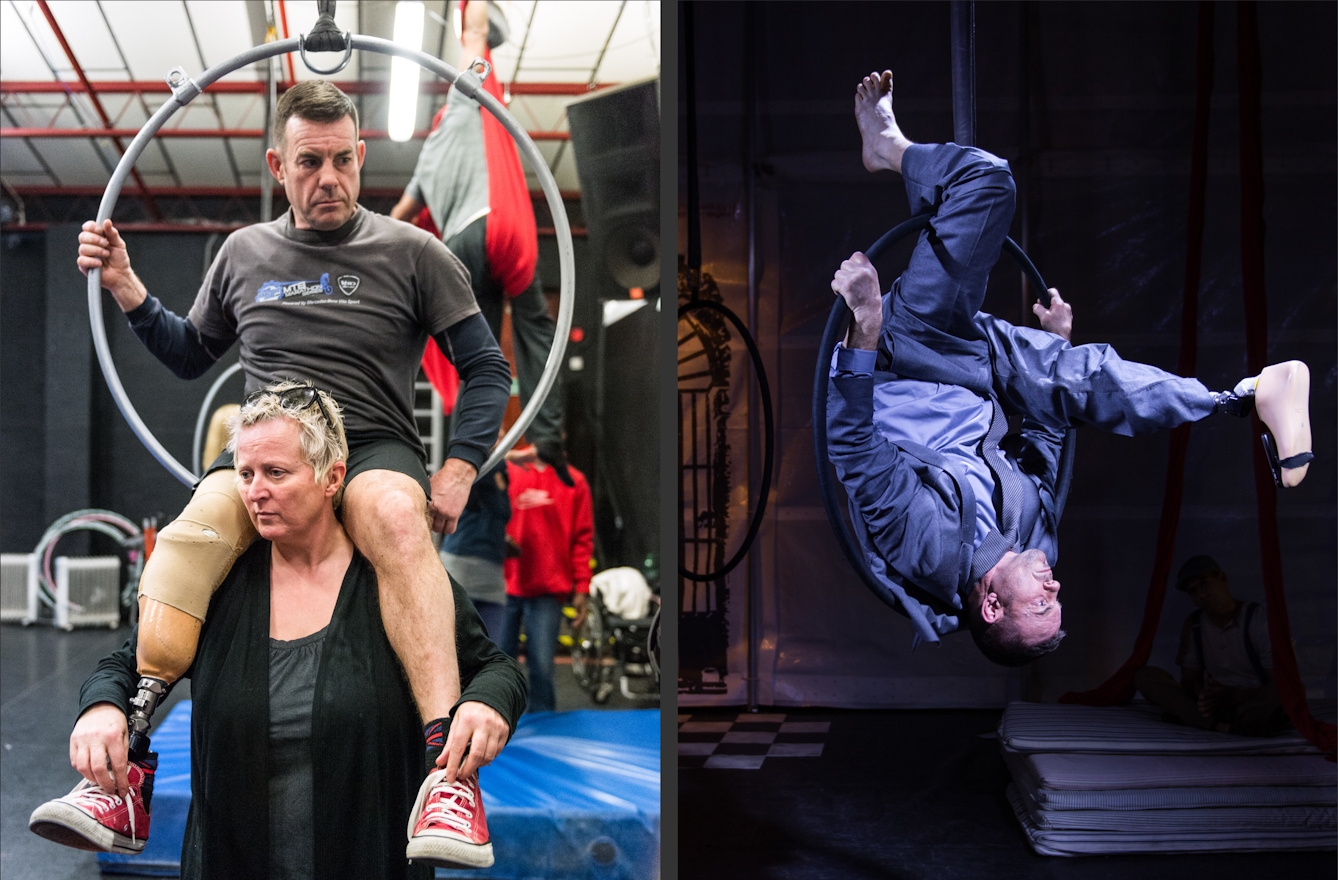
Belonging was a bittersweet aerial production, featuring hoops, trapeze and silks. In the left image performer Jez Scarratt sits on Jenny Sealey's shoulders during rehearsals, and then in action on the right during a dress rehearsal.
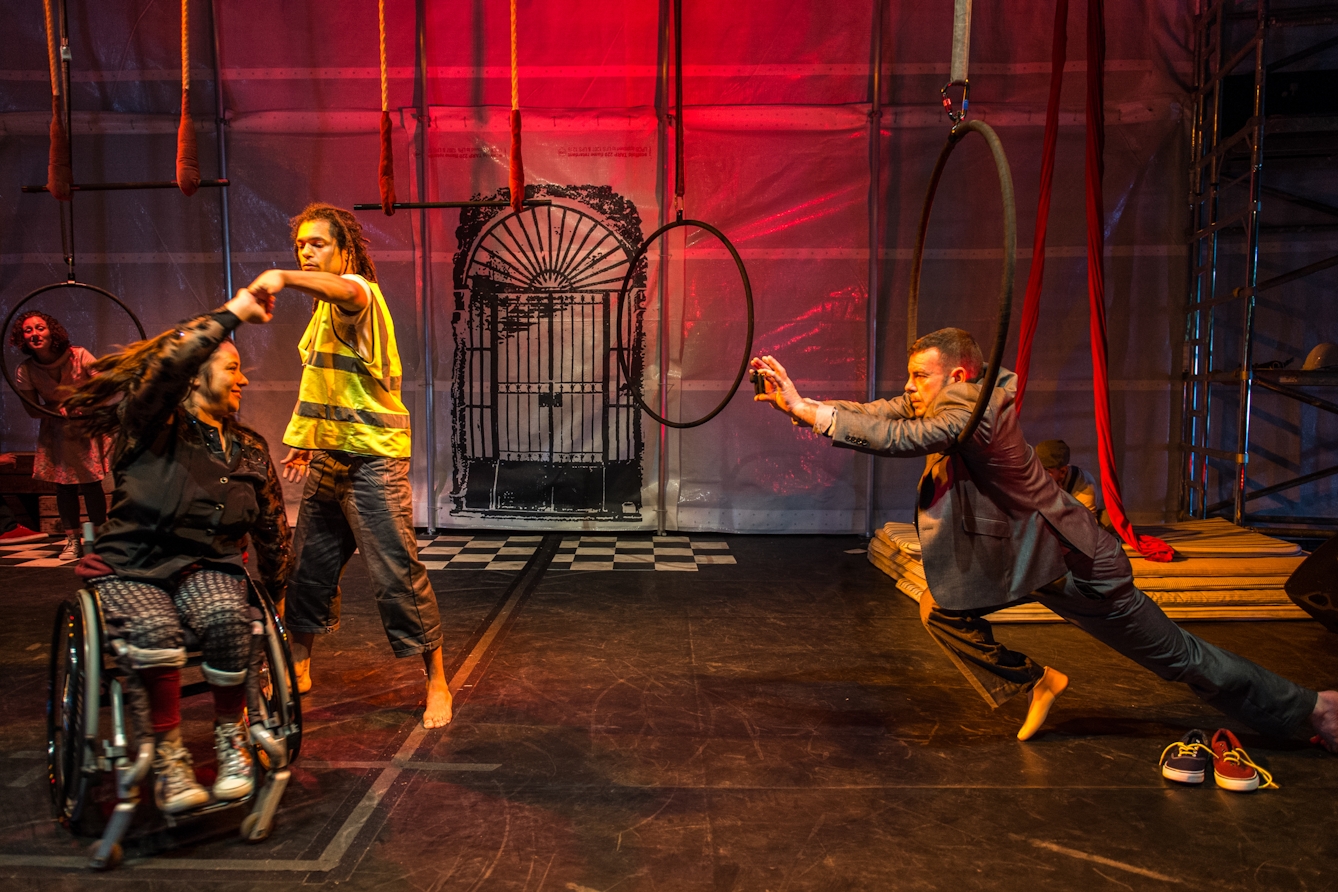
The production brought together a group of international artists to explore the idea of belonging and delve into what connects and divides us as people.
Missed opportunities
Jenny and I discuss the assumption that disabled actors can only take parts written as disabled. This is especially bitter when many parts that are written as disabled are typically played by non-disabled actors. Mat Fraser, who has long been involved with Graeae, was the first disabled actor to play Richard III on a major stage – despite the fact that Richard III is written as a disabled character. Meanwhile, the non-disabled Eddie Redmayne played Stephen Hawking in the film ‘The Theory of Everything’.
Other prominent non-disabled actors who have played disabled characters recently include James McAvoy in ‘Inside I’m Dancing’, Sally Hawkins in ‘The Shape of Water’, Javier Bardem in ‘The Sea Inside’ and Charlize Theron in ‘Mad Max Fury Road’.
“Acting is about being somebody else […] but did they try and audition any of us?” Jenny asks. “We’re not given the equality of opportunity to audition for those characters.”
Even where major parts are given to non-disabled actors, it is important to cast disabled actors elsewhere in pieces. Given that disabled people represent 20 per cent of the population, Jenny insists that there’s no reason not to employ us in every production, as well as front of house and backstage.
It’s “such a missed opportunity – what we bring to that character is an extra richness”, Jenny argues. But, without training, we’re not given the skills and experience for major parts, and without equality of access at audition, the opportunities out there even for excellent artists are sorely limited.
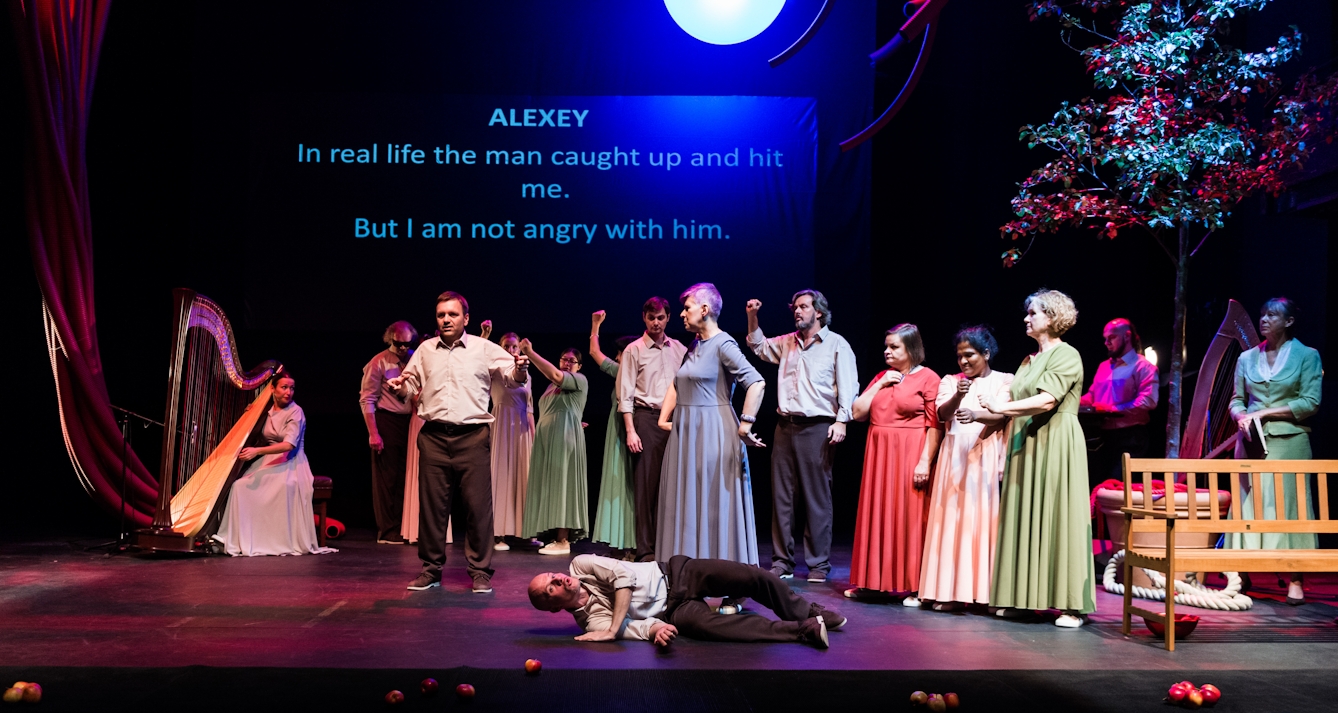
Performance of In Touch, an Inclusion Theatre Company and Theatre of Nations co-production in association with Graeae Theatre Company, National Theatre, Sense and The British Council, 2017.
Jenny says that some theatres are programming D/deaf and disabled artists – for example the Barbican, the New Wolsey and Battersea Arts Centre. But she feels, in general, “It’s always the little ones that are more robustly putting their politics on the stage,” while the bigger theatres get the credit.
Given that disabled people represent 20 per cent of the population … there’s no reason not to employ us in every production.
Even where D/deaf and disabled people are brought into theatre to tick boxes, Jenny feels “that’s part of our resilience as D/deaf and disabled people, in the sense that you stomach the tick box and we’re savvy in how we use that tick box in how we try to make change”. She doesn’t want D/deaf and disabled artists “to just be flavour of the month; we want to be flavour all the time – it’s having that artistic space to just find out what story you want to tell and how you want to tell it”.
Where D/deaf and disabled artists are offered opportunities, it can be done in a patronising manner, and Jenny has no time for this. “I’ve seen enough bad work that got on stage because the non-disabled world is too frightened to challenge disabled artists, but we need challenging: we haven’t had the same opportunities and we need to learn and we need to take it on the chin when we get constructive criticism.”
Jenny has “seen it with other disabled people, being applauded for getting up on stage, regardless of the quality of our art”, a position she sees as patronising. “We have to be good at what we do,” she says.
In Touch, 2017

Jenny Sealey directing performers during rehearsals for In Touch, which is part of a long-term project with Inclusion Theatre Company and Theatre of Nations, using the arts to connect deafblind, sighted and hearing people in different spaces.
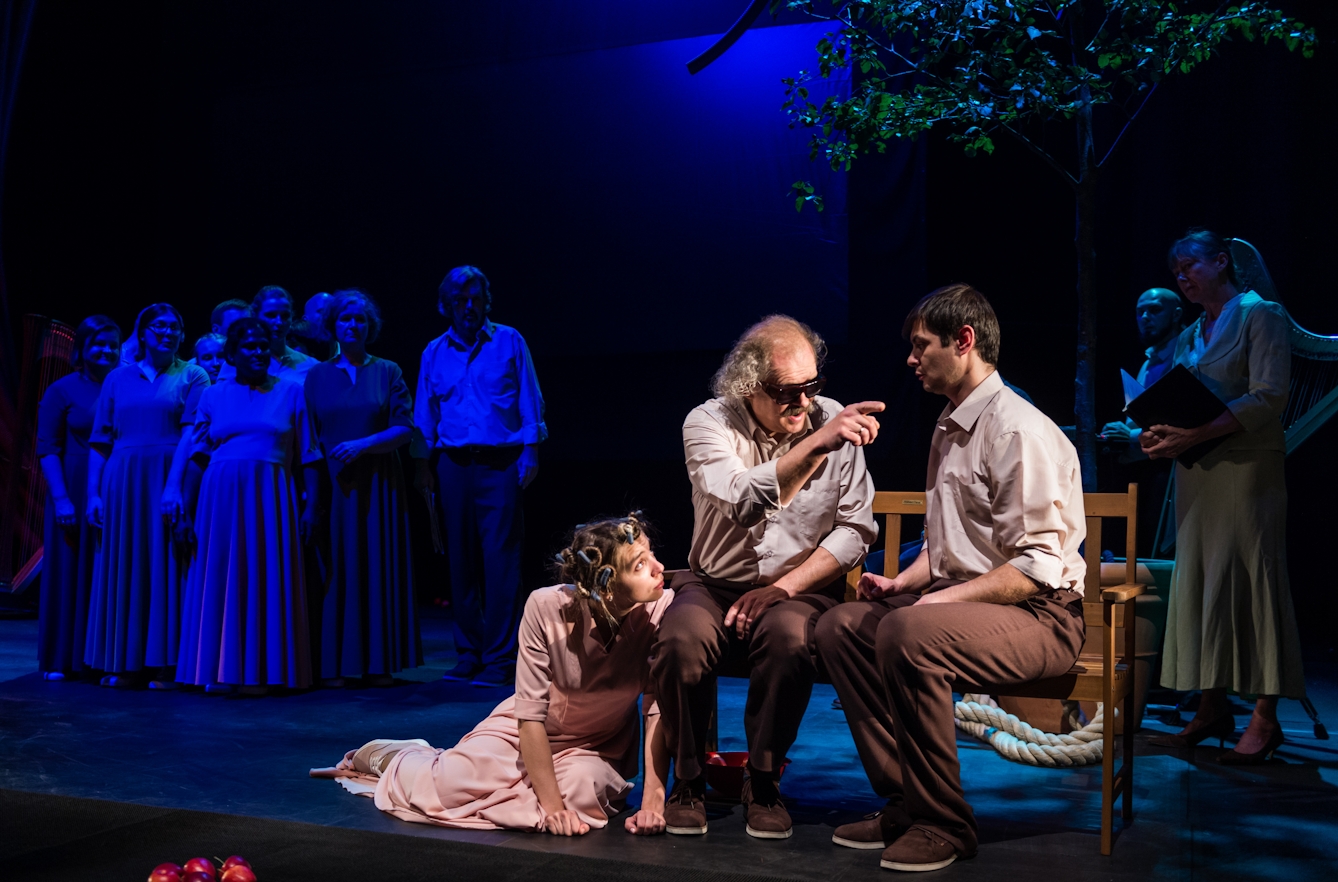
The production of In Touch captures the real stories of deafblind, blind, visually impaired, D/deaf, hard of hearing, sighted and hearing people, through an eclectic style of spoken, signed and physical theatre.
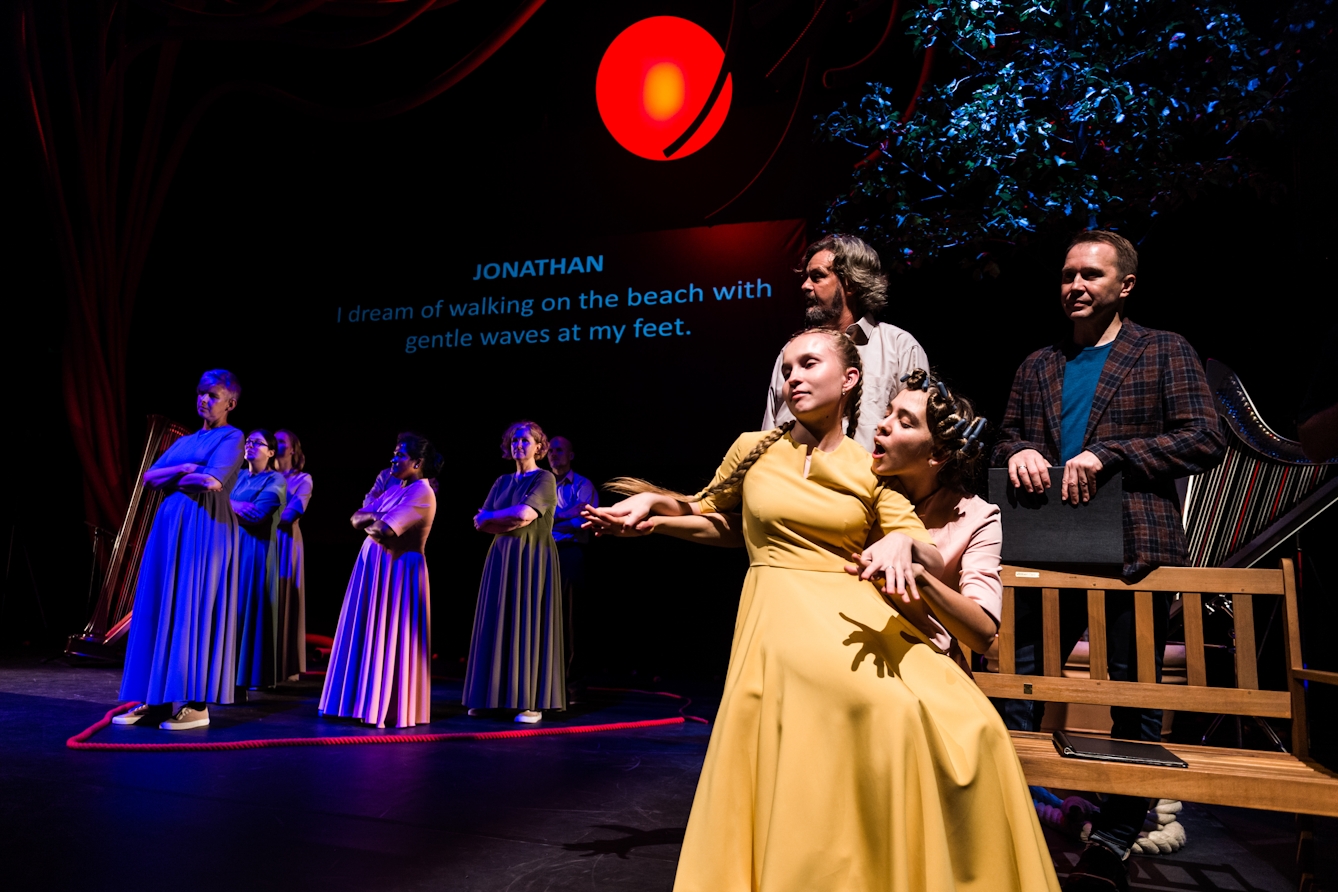
These real stories explore the emotional rollercoaster of being human, how we each navigate our lives and what happens when very different worlds collide and unite.
Contemplating the COVID-19 fallout
We are both concerned about the future of D/deaf and disabled theatre as a result of the COVID-19 pandemic. A “survival of the fittest” mentality is a real risk, as some actors can return to work, while those who are extremely vulnerable to coronavirus are forced to stay at home.
Jenny has ideas about how to ensure that this doesn’t happen with Graeae’s work: “We might have to explore plays with different mediums, live and non-live interaction. We don’t want to be in a position of only employing the fit people, which feels like censorship.”
Having transformed the face of theatre for D/deaf and disabled people during her work at Graeae, Jenny is keen to insist that theatre becomes even more welcoming to D/deaf and disabled people. “Graeae is not going away,” she says. “Our role becomes all the more important.”
About the contributors
Jamie Hale
Jamie is an artist, curator, and founder and artistic director of disability arts organisation CRIPtic Arts. They create poetry, comedy, scriptwriting and drama for page, stage and screen, and are currently directing a showcase at the Barbican Centre for autumn 2021 and a disability arts documentary. They have written for Wellcome Collection and the Guardian newspaper and have performed at venues including the Southbank Centre. Their poetry pamphlet, ‘Shield’, was published in January 2021.
Kirsten Irving
Kirsten Irving is a Lincs-born, London-based voice artist and poet. She has voiced work for a range of organisations including the Fairtrade Foundation, Royal Botanical Gardens Kew and the Women’s Institute, and can be heard on the Mosaic Science podcast.
Patrick Baldwin
Patrick is a specialist performing arts photographer and filmmaker working with a diverse range of clients, from the smallest theatre companies to the largest dance organisations.
